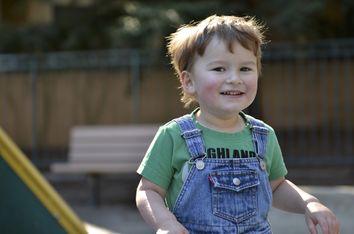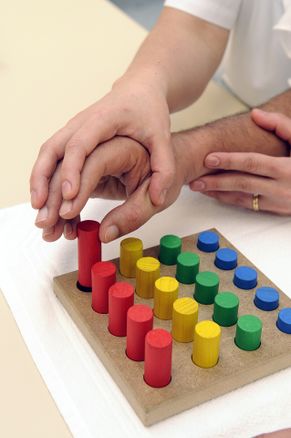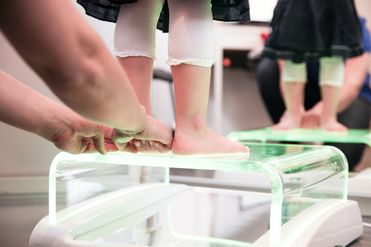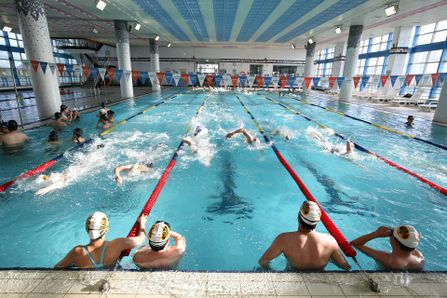Autism Spectrum Disorder and Motor Development
Original Editor - Alan Jit Ho Mak
Top Contributors - Alan Jit Ho Mak, Niha Mulla, Ahmed M Diab, Aminat Abolade, Mahbubur Rahman, Kim Jackson and Ines Musabyemariya
What is Autism Spectrum Disorder?[edit | edit source]
Austism Spectrum Disorder (ASD) is a complex neurological and developmental disability that manifests in early childhood. Autism affects the normal functioning of the brain and can be characterised by symptoms that can present in varying degrees, influencing communication, social interactions, and behaviour patterns.[1] Autism has been regarded as a life-long condition and it cannot be cured. However, severity may decrease through special education and treatments. Males tend to have a higher prevalence than females.[1]
Study has found that ASD can sometimes be detected at 18 months or younger. By age 2, a diagnosis by an experienced professional can be considered very reliable. But the stability of diagnosis at age 9 years was very high for autism, at age 2 years and less strong for pervasive developmental disorder not otherwise specified. [2]
To date, the cause of ASD is still unknown. Some argued it to be a result of, the abnormalities in the rate of early brain development.[3] Happe and Ronald (2008) explained the most common contributory genetic, cognitive as well as neurodevelopmental factors that contribute to the characteristic triad of symptoms of ASD. (For example, language delay, social impairment and repetitive behaviour).[4]
Kinney et al., (2010) have explored nine environmental factors for which exposure before conception, appears to be associated with an increased risk for Autism.[5] It is crucial to identify these factors which may include environmental change, and medical and physiotherapy interventions; which may be conceivable to limit the activating vulnerability and consequently lessen the prevalence of the vulnerabilities and their association with ASD.[6]
There is no doubt that the prevalence of ASD around the globe among children is on the rise. Phetrasuwan, Miles and Mesiiboy (2009) indicated that in the United States, there were 0.4 or 0.5 children with ASD among 1,000 children before 1985 and recently this has been increased to 1 in 150 children. According to 2010 statistics from the Centres for Disease Control and Prevention, 1/100 children in the US are diagnosed with some form of Autism.[7]
Children with ASD diagnosis present some core deficits, the symptoms can be diverse, ranging from those severely affected by numerous attributes to fewer characteristics.[7] However, Isaksen, Diseth, Schjølberg and Skjeldal (2013) argued that it may be unclear as to whether the increase in the prevalence of autism represents a genuine change in the commonality of the disorder or simply due to the methodological issues, broadening of diagnostic criteria, and increase public and professional familiarity with the conditions or better accessibility of services.[8]
Characteristics of Children with ASD with Motor Difficulties[edit | edit source]
Children with ASD may appear awkward in their motor skills and movement. Many of these coordination problems when combined with communication, social skills and behavioral problems can lead to more complex learning difficulties in later development such as playground and sporting skills.[9]
Exercise-based physiotherapy treatments include age-appropriate physical and motor skills, like jumping, clapping hands, skipping, hopping and throwing, kicking or catching a ball.
Motor Control Difficulties in Children with ASD[edit | edit source]
There are some children without a clear neurological disorder present with poor motor abilities before 7 years of age. Some of these children could be considered to have 'Developmental Coordination Disorder (DCD) in DSM criteria. However, it appears that the majority of children with DCD are identified after starting school. In some cases, poor motor performance at preschool age is considered as one of the first clear signs of another comorbidity for developmental disorders such as ASD or Attention Deficit Hyperactivity Disorder (ADHD). Although motor disorders can occur on their own, it has been suggested that they frequently coexist with ADHD and ASD [10] Motor control difficulties are very common in ASD children. DCD is found to present in about half of all individuals with ASD and ADHD. Recently, research has increased in the search for the links between DCD and ASD.[10][11][12]
A study by Kopp found that school girls with ASD and/or ADHD, with average or near average intellectual level, had more motor coordination problems than girls from the community population. 4 out of 5 preschool girls with ASD had motor coordination difficulties. Some differences in motor and sensory performance were found across the main diagnostic groups, with more gross motor and sensation impairments in the ASD group than the group with ADHD.[13] Motor coordination problems were also associated with a decreased ability in daily living skills. These results confirmed that poor levels of adaptive daily skills are not only related to social, communicative and attention impairments but also to motor difficulties.
Physiotherapy for Children with Autism Spectrum Disorder[edit | edit source]
One of the less discussed impacted areas of development in children with ASD is motor control. The developmental delays could affect the children’s gross and fine motor skills, such as walking and jumping, to more fine motor tasks like writing or buttoning a shirt. . The goal of physiotherapy is to gather information from parents, clinical physicians and other multi-disciplinary team members. The role of the physiotherapist is to take care of autistic children with motor impairments in the body (for instance; issues with respiratory control and coordination level, improvement in posture, and addressing misalignment in the musculoskeletal system including chest wall deformities as well as foot and ankle misalignment issues.[9]
Normally, the assessments and treatments can take place in various settings (for example: home, daycare, community centres, clinics, hospitals, rehabilitation centres and fitness centres.) Physiotherapists are also involved with rehabilitation after injuries where a child may be injured from a fractured leg and require rehabilitation treatments. However, physiotherapists must consider the diagnosis of autism when designing treatment sessions. This is because many of the physiotherapy sessions are very structured in nature. Teaching them to be comfortable and competent in their bodies is an essential part of the treatment.[9]
Hydrotherapy for Children with ASD[edit | edit source]
Regarding motor skill development, physiotherapists have argued that swim instruction methods for children with ASD can lead to faster learning of these skills. Some research argued that Hydrotherapy can be a beneficial form of exercise for autistic children. In addition, exercise-based physiotherapy can be highly beneficial for children with Autism.[14]
Aquatherapy has been commonly used to treat Autism patients. This usually takes place in a swimming pool. The pressure and temperature of the water pressing against the body can soothe an autistic child. Water as a property form can provide a claiming sensory input while the child performs exercises designed to improve range of motion and overall mobility. Warm water can reduce body weight by 90%, decrease the force of impact on the body, relax muscles and reduce spasticity, making water the ideal medium to rehabilitate the body.[14]
Promoting Physical Education and Physical Fitness to Children with ASD[edit | edit source]
One of the reasons for the low participation rate in Physical Education (PE) for children with ASD (53%) and ADHD (38%) could be associated with problems in main diagnosis and associated motor impairments.[13] Cairney et al (2005) found that children with DCD are less likely to be physically active.[15]
It has been argued that there is a need for better-tailored (Physical Education) PE for children with neuropsychiatric disorders, promoting the development of motor skills, with a sense of self-efficacy and physical fitness.[16]
The United Nations Sustainable Development Goals suggested the importance of early childhood development to enable children to reach their full potential, with physical development being the top priority, and a critical component for growth.[17] [18]It is widely accepted that children are required to perform basic motor skills such as locomotor (running and jumping), balance (standing on one leg), object control (catching, throwing and kicking) and fine motor tasks (using a pencil and scissors)[19][20]
For example, motor skills are said to form the foundation for sport-specific skills are predictive of physical activity participation and have been linked with cognitive outcomes.[20] Poor motor skills has also been reflected in childhood obesity, which is associated with short and long term adverse health related consequences.[21] Furthermore, a deficit in motor skills may insist, the presence of a developmental or medical condition, requiring specialised interventions.[22]
Children with ASD have poor motor performance, hence it is recommended that early intervention programs focus on motor development. Physiotherapists can stimulate the learning of functional motor skills to help the child compensate for motor skills disturbances.[23]
Conclusion[edit | edit source]
Physiotherapy treatments and education to Children with ASD are important due to the motor related difficulties they encounter during their developmental stage. The treatments have been successful in improving and decreasing the severity level of their weak muscle control which result in many other consequences when they grow up if left untreated.
Physiotherapists should engage in plays based therapy/exercise interventions, where they can teach the children to be confident and comfortable of their bodies.
It is also necessary to consider that the management of children with ASD is multidisciplinary, the physiotherapists are reminded to work hand in hand with other disciplines (Doctors, Occupational therapists, speech therapists, nurses, educators, etc.). This will lead to better outcome in the future for many children with ASD.
References[edit | edit source]
- ↑ 1.0 1.1 Durand VM, Barlow DH. Essentials of abnormal psychology. Cengage Learning; 2015.
- ↑ 19. Lord C, Risi S, DiLavore PS, Shulman C, Thurm A, Pickles A. Autism from 2 to 9 years of age. Archives of general psychiatry [Internet]. 2006;63(6):694–701.
- ↑ Caronna EB, Milunsky JM, Tager-Flusberg H. Autism spectrum disorders: clinical and research frontiers. Archives of disease in childhood. 2008 Jun 1;93(6):518-23.
- ↑ Happé F, Ronald A. The ‘fractionable autism triad’: a review of evidence from behavioural, genetic, cognitive and neural research. Neuropsychology review. 2008 Dec;18(4):287-304.
- ↑ Kinney DK, Barch DH, Chayka B, Napoleon S, Munir KM. Environmental risk factors for autism: do they help cause de novo genetic mutations that contribute to the disorder?. Medical Hypotheses. 2010 Jan 1;74(1):102-6.
- ↑ Herbert MR. Contributions of the environment and environmentally vulnerable physiology to autism spectrum disorders. Current opinion in neurology. 2010 Apr 1;23(2):103-10.
- ↑ 7.0 7.1 Phetrasuwan S, Miles MS, Mesibov GB. Defining autism spectrum disorders. Journal for Specialists in Pediatric Nursing. 2009 Jul 1;14(3):206.
- ↑ Isaksen J, Diseth TH, Schjølberg S, Skjeldal OH. Autism spectrum disorders–are they really epidemic?. European Journal of Paediatric Neurology. 2013 Jul 1;17(4):327-33.
- ↑ 9.0 9.1 9.2 Jebakumar AZ. PHYSIOTHERAPY CURES AUTISM: A REVIEW.
- ↑ 10.0 10.1 Dewey D, Cantell M, Crawford SG. Motor and gestural performance in children with autism spectrum disorders, developmental coordination disorder, and/or attention deficit hyperactivity disorder. Journal of the International Neuropsychological Society. 2007 Mar;13(2):246-56.
- ↑ Green D, Charman T, Pickles A, Chandler S, Loucas TO, Simonoff E, Baird G. Impairment in movement skills of children with autistic spectrum disorders. Developmental Medicine & Child Neurology. 2009 Apr;51(4):311-6.
- ↑ Pan CY, Tsai CL, Chu CH. Fundamental movement skills in children diagnosed with autism spectrum disorders and attention deficit hyperactivity disorder. Journal of autism and developmental disorders. 2009 Dec;39(12):1694-705.
- ↑ 13.0 13.1 Kopp S, Beckung E, Gillberg C. Developmental coordination disorder and other motor control problems in girls with autism spectrum disorder and/or attention-deficit/hyperactivity disorder. Research in developmental disabilities. 2010 Mar 1;31(2):350-61.
- ↑ 14.0 14.1 Lang R, Koegel LK, Ashbaugh K, Regester A, Ence W, Smith W. Physical exercise and individuals with autism spectrum disorders: A systematic review. Research in autism spectrum disorders. 2010 Oct 1;4(4):565-76.
- ↑ Cairney J, Hay JA, Faught BE, Wade TJ, Corna L, Flouris A. Developmental coordination disorder, generalized self-efficacy toward physical activity, and participation in organized and free play activities. The Journal of Pediatrics. 2005 Oct 1;147(4):515-20.
- ↑ Chan JM, Lang R, Rispoli M, O’Reilly M, Sigafoos J, Cole H. Use of peer-mediated interventions in the treatment of autism spectrum disorders: A systematic review. Research in autism spectrum disorders. 2009 Oct 1;3(4):876-89.
- ↑ Black MM, Walker SP, Fernald LC, Andersen CT, DiGirolamo AM, Lu C, McCoy DC, Fink G, Shawar YR, Shiffman J, Devercelli AE. Early childhood development coming of age: science through the life course. The Lancet. 2017 Jan 7;389(10064):77-90.
- ↑ World Health Organization. International Classification of Functioning, Disability, and Health: Children & Youth Version: ICF-CY. World Health Organization; 2007.
- ↑ Robinson LE, Stodden DF, Barnett LM, Lopes VP, Logan SW, Rodrigues LP, D’Hondt E. Motor competence and its effect on positive developmental trajectories of health. Sports medicine. 2015 Sep;45(9):1273-84.
- ↑ 20.0 20.1 Barnett LM, Van Beurden E, Morgan PJ, Brooks LO, Beard JR. Childhood motor skill proficiency as a predictor of adolescent physical activity. Journal of adolescent health. 2009 Mar 1;44(3):252-9.
- ↑ Rivilis I, Hay J, Cairney J, Klentrou P, Liu J, Faught BE. Physical activity and fitness in children with developmental coordination disorder: a systematic review. Research in developmental disabilities. 2011 May 1;32(3):894-910.
- ↑ Poon JK, Larosa AC, Shashidhar Pai G. Developmental delay: timely identification and assessment. Indian pediatrics. 2010 May;47(5):415-22.
- ↑ Eunice Kennedy & Shriver National Institute of Child Health and Human Development. U.S. National Institute of Health. Physical therapy for autism. Department of Health and Human Services; 2017.
- ↑ The Importance of Motor Function and Physical Activity in Autism Spectrum Disorder Available from: https://www.youtube.com/watch?v=nJIVChOpVhk [last accessed 10/09/2020]










